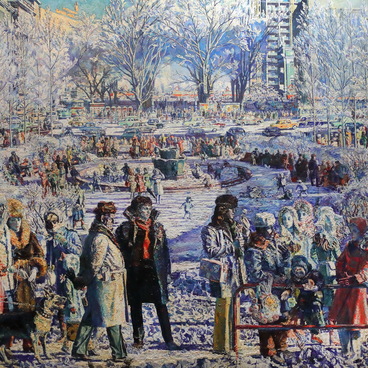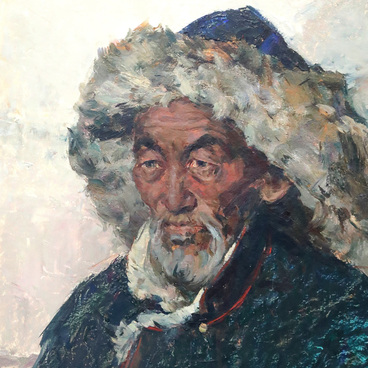The Ural artist Mikhail Gumyonnykh took up painting at a relatively late age. Gumyonnykh had to work painstakingly hard because he never received any art education. His efforts earned him the status of one of the most significant artists in the history of the Ural art.
The highlight of Mikhail Gumyonnykh’s career occurred in the 1960s. At this time, the “austere style” had just gained popularity in Soviet art: its landscapes were dedicated to the nature of the “harsh” regions, such as the North, Kamchatka, and the Urals.
The artist traveled a lot: he visited the Russian North, the Volga region, central Russia, the Urals, Chukotka, Kamchatka, Baikal, Armenia, and Crimea. He often painted from nature. He would later use his studies made in the open air to create paintings in his workshop. Mountains, hills, volcanoes, northern seas, and full-flowing rivers — all that became the subjects of Mikhail Gumyonnykh’s works.
In the 1970s, in search of inspiration, the artist went on a journey through the Northern Urals. Among the places he saw was the Vishera River — the left tributary of the Kama River located in Perm Krai. Its length is 415 km, and it is one of the most picturesque rivers in the Urals. Its banks are home to unique natural landmarks. The Vishera and its riches have always attracted numerous tourists who choose this place either for rafting or hiking. Gumyonnykh was fascinated with the grandeur of this area, which seemed restrained and yet radiated dignity, might, and originality, and created the landscape housed by the museum.
The painting “Govorlivy Rock on the banks of the Vishera River” depicts one of the most picturesque and majestic rocks in the area. This is a tall rock with its base submerged in the water. It consists of massive, almost horizontal layers of limestone. Its length is almost 2 km, and its height reaches 60 m.
At the rock’s foot is a settlement near the edge of the forest. The distance reveals the top of Polyudov Kamen or Polyud Rock, which looks like a frozen wave and is a popular tourist attraction of the Perm region.
In this painting, Gumyonnykh warranted his name of “the singer of the North” through the use of muted colors, monumental imagery, and a large-scale pictorial manner. The artist also worked in the genres of portrait and still life and participated in numerous exhibitions.
The highlight of Mikhail Gumyonnykh’s career occurred in the 1960s. At this time, the “austere style” had just gained popularity in Soviet art: its landscapes were dedicated to the nature of the “harsh” regions, such as the North, Kamchatka, and the Urals.
The artist traveled a lot: he visited the Russian North, the Volga region, central Russia, the Urals, Chukotka, Kamchatka, Baikal, Armenia, and Crimea. He often painted from nature. He would later use his studies made in the open air to create paintings in his workshop. Mountains, hills, volcanoes, northern seas, and full-flowing rivers — all that became the subjects of Mikhail Gumyonnykh’s works.
In the 1970s, in search of inspiration, the artist went on a journey through the Northern Urals. Among the places he saw was the Vishera River — the left tributary of the Kama River located in Perm Krai. Its length is 415 km, and it is one of the most picturesque rivers in the Urals. Its banks are home to unique natural landmarks. The Vishera and its riches have always attracted numerous tourists who choose this place either for rafting or hiking. Gumyonnykh was fascinated with the grandeur of this area, which seemed restrained and yet radiated dignity, might, and originality, and created the landscape housed by the museum.
The painting “Govorlivy Rock on the banks of the Vishera River” depicts one of the most picturesque and majestic rocks in the area. This is a tall rock with its base submerged in the water. It consists of massive, almost horizontal layers of limestone. Its length is almost 2 km, and its height reaches 60 m.
At the rock’s foot is a settlement near the edge of the forest. The distance reveals the top of Polyudov Kamen or Polyud Rock, which looks like a frozen wave and is a popular tourist attraction of the Perm region.
In this painting, Gumyonnykh warranted his name of “the singer of the North” through the use of muted colors, monumental imagery, and a large-scale pictorial manner. The artist also worked in the genres of portrait and still life and participated in numerous exhibitions.

